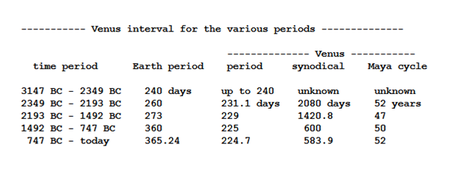Venus
|
"Venus would react quite differently to a plasmasphere contact. Venus has an extremely heavy atmosphere, nearly 100 times the density of the Earth's atmosphere. Its atmosphere is like an ocean. Because of its density and the 700 degree Fahrenheit surface temperature, the atmosphere represents the location of Venus's exterior electrical charge.
"The dense atmosphere would therefore be the location of the electrical forces impinging on Venus in meeting another planet. But rather than being transmitted to the surface of one hemisphere, the forces would be absorbed by the atmosphere and distributed around the planet, buffeting the crust with a compression wave from all directions. The planet would not likely relocate to a new orbit, and in fact it looks like the orbital period of Venus has not changed significantly since 3147 BC, except for becoming circular at some point after 685 BC." (Cook, Appendix B) |
The orbit of Venus is today inclined about 3.61 degrees to the equatorial of the Sun, the second least inclination (after Mercury at zero degrees).
|
